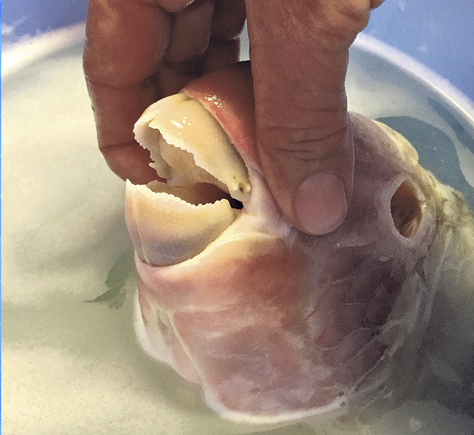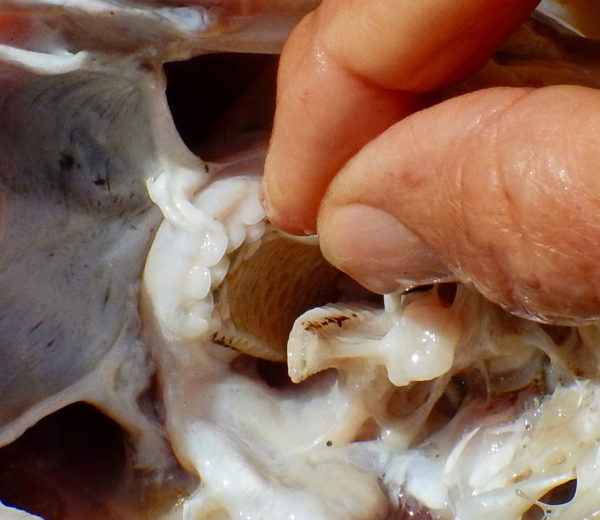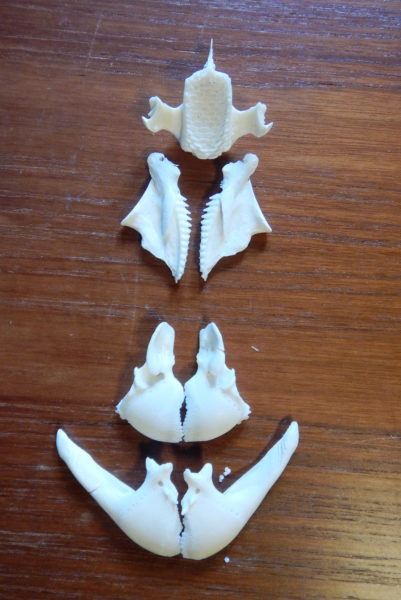Published in the Ocean Watch column, Honolulu Star-Advertiser © Susan Scott
May 9, 2016
While snorkeling I found a big, pink parrotfish head bumping along the sand near the shorebreak. The freshly dead fish had such striking teeth jutting from its mouth, I picked it up for a closer look. When I clutched the rolling head, though, my fingers touched the fish’s pharyngeal mill, a special set of teeth embedded in the throat. I knew about this parrotfish trait but had never seen it. So I took the head home. After two days of bleaching, cutting, boiling, drying and scrubbing my apartment of fish smell, I had the teeth free of flesh for examination. It was well worth the work.
 Parrotfish have protruding beaklike teeth, used to bite off pieces of coral rock to get to the
Parrotfish have protruding beaklike teeth, used to bite off pieces of coral rock to get to the
algae growing on the surface, or to scrape live coral heads to get to the corals’ soft bodies.
©2016 Susan Scott
In addition to their rainbow-colored bodies, parrotfish resemble parrots in their protruding beaklike teeth, two massive uppers and two lowers, each pair with a gap in the middle. Parrotfish also talk, sort of, making distinct crunching sounds as they bite off pieces of coral rock. Most species eat rocks to get the algae growing on the surface. Other parrotfish excavate hard sand surfaces to get algae stubble so short it’s unavailable to other plant-eating fish.
Still other parrotfish, two in Hawaii, scrape live coral heads to eat the corals’ soft bodies. These parrotfish leave conspicuous patches in the shape of their teeth.
Whether they eat algae or live coral, parrotfish bite off more than they can chew because the nutrients they need are growing on, or living inside, chunks of solid limestone. And that’s where the pharyngeal mill comes in.
 Throat teeth AKA pharyngeal mill.
Throat teeth AKA pharyngeal mill.
©2016 Susan Scott
This second set of teeth in the parrotfish’s throat works like a coffee grinder. Molars on plates move back and forth, pulverizing the rocks to bits. As the tiny stones move on, the parrotfish’s digestive system extracts the nutrients, churns the rubble into fine sand and expels the grains through the anus.
In addition to their jaw-dropping beauty, these extraordinary fish change sex as needed, sleep in self-made mucus sleeping bags and play a large role in keeping our reefs healthy. Parrotfish bite marks on living coral open up spaces for other animals to settle and grow. Parrotfish also mow the reef’s lawns and supply much of the sand that houses countless fish and invertebrates.
Spearfishers have killed the good-tasting parrotfish to the point they’re now rare in Hawaii waters outside of protected areas. You can help Hawaii’s parrotfish, and in turn our coral reefs, by not spearing parrotfish or ordering them in restaurants.
Of course, without supporting tissue, my parrotfish teeth fell apart. Still, I treasure them. The little mound of teeth now sits on my shelf as a tribute to a truly remarkable fish.
 Parrotfish teeth cleaned: Pharyngeal mill (top three pieces).
Parrotfish teeth cleaned: Pharyngeal mill (top three pieces).
Mouth teeth (bottom four pieces.)
©2016 Susan Scott